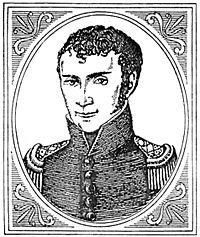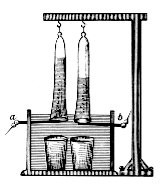Johann Wilhelm Ritter facts for kids
Quick facts for kids
Johann Wilhelm Ritter
|
|
|---|---|

Ritter in the uniform of the Bavarian Academy of Sciences, about 1804.
|
|
| Born | 16 December 1776 Samitz, Silesia, Holy Roman Empire
|
| Died | 23 January 1810 (aged 33) Munich, Bavaria
|
| Nationality | German |
| Known for | Electrochemistry Ultraviolet light |
| Scientific career | |
| Fields | Physics |
Johann Wilhelm Ritter was a clever German scientist. He was a chemist, a physicist, and even a philosopher. He was born in a place called Samitz (now in Poland) in 1776. He passed away in Munich in 1810.
Contents
Ritter's Early Life and Studies
Johann Ritter started his science journey early. At 14, he became an apprentice to a pharmacist. This job helped him learn a lot about chemistry. Later, in 1796, he began studying medicine at the University of Jena.
Ritter was a self-taught scientist. This means he learned a lot on his own. He did many experiments. These experiments were about chemistry, electricity, and other interesting topics.
Ritter and the Romantic Movement
Ritter was part of a big movement called German Romanticism. He knew many famous people of his time. These included Johann Wolfgang von Goethe and Alexander von Humboldt.
He was also good friends with Hans Christian Ørsted. Ørsted was another important scientist. Ritter's ideas even influenced Ørsted's own work.
Discoveries in Electricity
Ritter was very interested in how electricity worked. He studied what happened when electricity was used with living things. Other scientists like Luigi Galvani and Alessandro Volta had different ideas. Ritter thought that electricity came from chemical reactions. This idea is closer to what we know today.

In 1800, a new invention came out. It was called the voltaic pile. This was an early type of battery. Soon after, scientists found that electricity could break water apart. Ritter also discovered this on his own. He even measured how much hydrogen and oxygen were made.
Ritter also found out about electroplating. This is a way to coat one metal with another using electricity. In 1802, he built his own electrochemical cell. It was made of copper discs and cardboard soaked in salt water.
Ritter's Self-Experiments
Ritter was very brave, or perhaps a bit too daring! He did many experiments on himself. He would touch the ends of his battery to his own hands, eyes, ears, nose, and tongue. He wanted to see how electricity affected his body. He even wrote about how the two different ends of the battery felt.
Finding Ultraviolet Light
Ritter believed that nature had many "forces" that were connected. In 1800, another scientist found "heat rays" (now called infrared radiation). These rays were beyond the red part of the rainbow. Ritter wondered if there were "cooling" rays beyond the violet part.
He didn't find exactly what he expected. But he noticed something amazing. A chemical called silver chloride changed color faster. It turned from white to black when placed beyond the violet end of the Sun's light. These "chemical rays" were later called ultraviolet radiation. This was a very important discovery!
Challenges and Later Life
Some of Ritter's discoveries were very important. But he also claimed to find things that other scientists could not confirm. For example, he said the Earth had electric poles. He also claimed he could break water apart using magnets instead of batteries.
Ritter never had a regular job as a university professor. He struggled to earn money. In 1804, he became a member of the Bavarian Academy of Science. He got married and had four children. But he found it hard to support his family. He had money problems and was often sick. This might have been because of his risky self-experiments. He died young in 1810, without much money.
See also
 In Spanish: Johann Wilhelm Ritter para niños
In Spanish: Johann Wilhelm Ritter para niños
- Timeline of hydrogen technologies
- Timeline of particle discoveries

